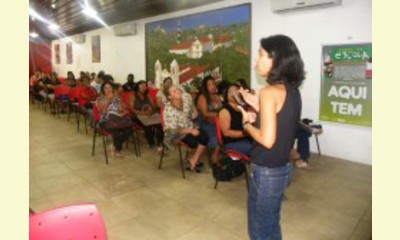|
|
The City of Olinda (Brazil) Promotes the Culture of Peace
un articulo por Cristiane Cruz, Town Hall, Olinda, Brazil
Health and education professionals in Olinda have attended lectures on the different types of violence, violence in schools and how to identify and refer children who are victims of abuse.

Photo by the Secretary of Health of Olinda
click on photo to enlarge
Culture of Peace. This was the theme of training sessions provided by the School Health Program (PSE) of the Secretary of Health of Olinda on Thursday from 8:00 until 17:00 at the Nelson
Correia Auditorium of the Secretary of Education. The event which was co-sponsored by Secretary of Education brought together about 100 people.
The objective was to prepare health and education professionals to develop activities promoting culture of peace in schools and and on the steps to be taken in the event of abuse. The training included lectures by social assistant Claudecir Vitorino and Silvia Rocha of the Team for Prevention of Violence and Accidents (NUPAV) and group dynamics with Barros Angelica of NUPAV and Sirley Jordan, the coordinator of PSE.
The meeting was attended by professionals, including psychologists, social workers, nurses, community health workers, teachers and principals of municipal schools. The event was organized in partnership with the Center for Prevention of Accidents and Violence (NUPAV) and the Program of Continuing Education.
(Click here for a Portuguese version of this article)
|








|
DISCUSSION
Pregunta(s) relacionada(s) al artículo :
How can culture of peace be developed at the municipal level?,
* * * * *
Comentario más reciente:
:
International Cities Choose Peace
J. Fred Arment
arment@internationalcitiesofpeace.org
International Cities of Peace, an association of global cities of peace, is using the U.N. Culture of Peace tenets as the guideline for forming initiatives. To date, thirty-one cities are part of the association. Some are grassroots organizations, others have the firm commitment by resolution or proclamation from the city council.
International Cities of Peace include the following:
• Dayton, Ohio, U.S.A.
• Eugene, Oregon, U.S.A.
• Unity Village, Missouri, U.S.A
• Coventry, England
• Bradford, England
• Guadalajara, Jalisco, Mexico
• Bukavu, Democratic Republic of Congo
• Mataki, Philippines
• Pathuthani, Thailand
• Fizi, Democratic Republic of Congo
• Lake County, California, U.S.A.
• Aba, Abia State, Nigeria
• Nagpur, India
• Reno, Nevada, U.S.A.
• Bujumbura, Burundi
• Mzuzu and Lilongwe, Malawi
• Tunis, Tunisia
• Tuolumne County, California, U.S.A.
• Bihac, Bosnia, Herzegovina
• Yaounde, Cameroon
• Freetown, Sierra Leone
• Nyala, Darfur, Sudan
• Bujumbura, Burundi
• Victoria, British Columbia, Canada
• Nakuru, Kenya
• Calgary, Alberta, Canada
• Kathmandu, Nepal
• Detroit, Michigan, U.S.A.
• Egg Harbor City, New Jersey, U.S.A.
• Warrake, Nigeria
• Kalamazoo, Michigan, U.S.A.
To start an initiative, go to the association's website for resources and tools.

|
|









